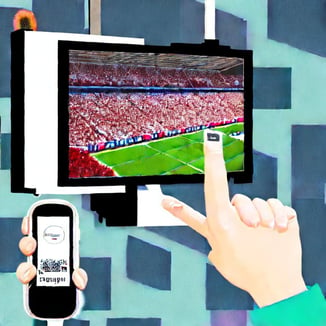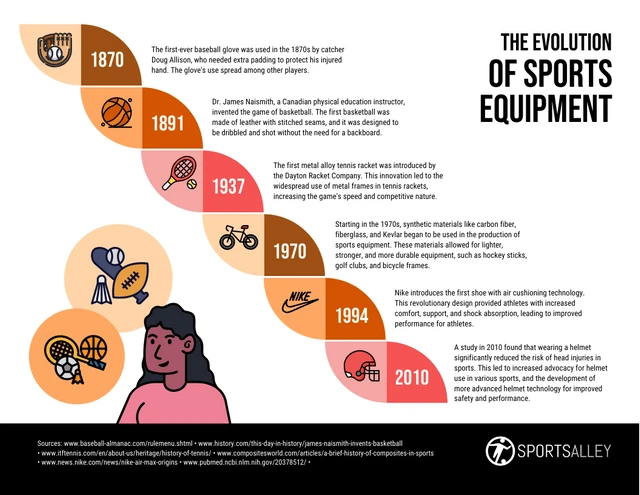technology. From the advent of wearable devices to the immersive experiences offered by virtual reality, the evolution of sports technology has been nothing short of remarkable.
The continuous evolution of sports technology has not only been remarkable but has also reshaped the very fabric of the sporting world. It’s a journey that has not merely improved athlete performance but has touched every aspect of the sports experience, from training to fan engagement. From the advent of wearable devices that discreetly monitor vital statistics to the immersive experiences offered by virtual reality (VR), this technological revolution has brought about a paradigm shift.
Wearable Technology: Pioneering Personalization
Wearable devices, often worn discreetly on athletes’ bodies, have turned sports into a highly personalized endeavor. They have enabled athletes to gather an abundance of data about their performance, such as heart rate, sleep patterns, and recovery metrics. This wealth of information has empowered athletes to make precise adjustments to their training routines, optimize their peak performance, and extend their careers. It’s not just about improving performance; it’s about optimizing an athlete’s overall well-being.
Data Analytics: The Science of Sporting Success
The emergence of data analytics in sports has transformed the game itself. It’s no longer just about gut instincts and intuition; data-driven decisions now reign supreme. Advanced software and algorithms dissect vast amounts of data, revealing insights that were previously hidden. Teams can scrutinize player performance, fine-tune strategies, and anticipate opponents’ moves. In essence, data analytics has become the compass guiding teams toward victory, making every decision a calculated one.
Virtual Reality (VR): A New Dimension in Training
When it comes to training, the adoption of virtual reality has taken athletes to new heights. VR has transcended the limits of the physical world, allowing athletes to practice in immersive virtual environments that replicate game scenarios with stunning realism. Whether it’s a tennis player refining their backhand or a firefighter honing their reaction to emergencies, VR training offers a safe and realistic platform to rehearse, learn, and adapt. It’s a game-changer that propels athletes and professionals to their best when it matters most.
Augmented Reality (AR): Transforming the Fan Experience
Sports technology isn’t only benefiting athletes; it’s enhancing the fan experience as well. Augmented reality (AR) has introduced a new layer of interactivity to live events. Fans can now access real-time information, player statistics, and instant replays overlaid onto their view using AR apps and devices. This dynamic engagement has redefined how fans connect with their favorite sports, making each moment more immersive and enjoyable. AR has transformed spectators into active participants, deepening their connection with the game.
Esports: A New Frontier of Competitive Gaming
The marriage of sports and technology has also given birth to a new kind of competition – esports. Esports, competitive video gaming, has skyrocketed in popularity, attracting professional players, lucrative sponsorships, and global audiences. It’s an unconventional sport that showcases the fusion of technology and skill, where players are celebrated just like traditional athletes. Esports represents a bold new frontier, blurring the lines between the physical and digital worlds.
As we look ahead, the trajectory of sports technology remains one of endless possibilities. The integration of artificial intelligence (AI), further advancements in virtual and augmented reality, and innovations yet to be conceived promise to redefine the world of sports in ways we can scarcely imagine. This technological journey is not only remarkable but an exhilarating one, promising to take sports to heights yet uncharted, and sports enthusiasts along for an unforgettable ride.
Additionally, you can find further information on this topic by visiting this page: Sports | Definition, History, Examples, & Facts | Britannica

The journey of sports technology begins with the rise of wearables. Wearable devices, such as fitness trackers and smartwatches, have become ubiquitous accessories for athletes and fitness enthusiasts alike. These gadgets provide real-time data on metrics like heart rate, steps taken, and sleep patterns. For athletes, this data is invaluable for tracking performance, optimizing training routines, and preventing injuries. Wearables have transformed the way athletes understand and improve their physical well-being.
The evolution of sports technology traces its origins to the proliferation of wearables, marking a significant turning point in the world of athletics. Wearable devices, including fitness trackers and smartwatches, have seamlessly integrated into the lives of athletes and fitness enthusiasts, earning their place as indispensable tools. Let’s delve deeper into how wearables have ushered in a new era of athletic performance and well-being:
1. Real-Time Data Insights: Wearables act as personal data hubs, continuously collecting a wealth of information about an athlete’s body and activities. From heart rate monitoring to step counting and even sleep pattern analysis, these devices offer real-time data insights that were previously inaccessible. Athletes can now closely monitor their physical condition with unprecedented accuracy.
2. Performance Tracking: For athletes, data is gold. Wearables empower athletes to track their performance metrics with precision. They can measure everything from running speed and distance to heart rate zones during workouts. This data allows for informed decisions on training intensity, duration, and recovery periods, ultimately leading to enhanced performance.
3. Injury Prevention: Understanding the body’s limits is vital for injury prevention. Wearables provide athletes with valuable information about overexertion, fatigue, and strain. By analyzing this data, athletes can adjust their training routines to minimize the risk of injuries and ensure long-term physical well-being.
4. Customized Training: Wearables enable athletes to tailor their training plans to their unique physiology and goals. By analyzing data trends over time, athletes can make informed adjustments to their workouts, ensuring that they are both effective and safe. This level of customization maximizes training efficiency.
5. Recovery Optimization: Recovery is as crucial as training itself. Wearables help athletes monitor their sleep quality and patterns, offering insights into their overall recovery status. This information allows athletes to adjust their sleep routines and recovery strategies to optimize their physical and mental well-being.
6. Performance Metrics: Athletes can set and track specific performance metrics and goals using wearables. Whether it’s achieving a certain heart rate during a marathon or maintaining a specific cadence while cycling, these devices serve as constant reminders and motivators to reach new heights.
7. Data-Driven Competitions: Wearables have given rise to data-driven competitions within the athletic community. Athletes can challenge themselves and others based on performance data, creating a sense of camaraderie and motivation for improvement.
8. Enhanced Coaching: Coaches and trainers can use data from wearables to better understand their athletes’ progress and make informed coaching decisions. This leads to more personalized and effective training programs.
9. Psychological Impact: Wearables not only influence physical well-being but also have a psychological impact. Athletes gain a deeper connection to their bodies and a heightened awareness of their capabilities. This can boost confidence and motivation.
10. Long-Term Health: Beyond sports, wearables promote long-term health awareness. Athletes are encouraged to prioritize their overall well-being, not just their immediate athletic goals. This shift in mindset can lead to healthier lifestyles both on and off the field.
In conclusion, wearables have revolutionized the athletic landscape, providing athletes with a treasure trove of real-time data and insights. This technology empowers athletes to make informed decisions, optimize their training, and prioritize their long-term physical well-being. It’s not just about improving performance; it’s about fostering a holistic approach to health and athletic excellence. The journey of sports technology, which began with wearables, continues to shape the future of athletics, promising even more innovative ways to enhance performance and well-being.
If you’d like to dive deeper into this subject, there’s more to discover on this page: The Brave New World of Wearable Technology: What Implications …

As technology advanced, so did the ability to collect and analyze data. Data analytics has become a critical tool for sports teams and athletes. Sophisticated software and algorithms crunch massive amounts of data to extract insights into player performance, opponent strategies, and injury prevention. This data-driven approach has revolutionized decision-making in sports, offering a competitive advantage through strategic planning and performance enhancement.
nullShould you desire more in-depth information, it’s available for your perusal on this page: What is Wearable Technology? Definition, Uses and Examples

Virtual reality has taken sports training to a new dimension. Athletes can now immerse themselves in virtual environments that closely replicate real-game scenarios. Whether it’s a soccer player practicing penalty kicks or a quarterback reading defenses, VR training provides an unparalleled level of realism. Athletes can fine-tune their skills, make split-second decisions, and simulate high-pressure situations, all within a controlled and safe virtual space. VR training has not only elevated individual performance but has also become an essential tool for team preparation.
The advent of virtual reality (VR) in sports training has ushered in a transformative era, offering athletes a cutting-edge tool to hone their skills and prepare for the most demanding situations they may encounter on the field.
In the realm of skill development, VR has brought about a revolution. Athletes from various disciplines, whether it’s a basketball player perfecting their free-throw technique or a golfer refining their swing, can step into a virtual arena that replicates real-world scenarios with astonishing precision. This level of realism allows athletes to fine-tune their movements, correct flaws in their technique, and master the intricate details of their sport.
VR’s true power shines when athletes seek to simulate the high-pressure moments that define competitive sports. In the immersive world of VR, soccer players can stand on the penalty spot, facing a virtual goalkeeper and a roaring crowd, rehearsing penalty kicks with unwavering focus. Quarterbacks can step into the virtual pocket, reading the movements of a lifelike defense, and making split-second decisions that mirror the intensity of a real game.
Crucially, VR training provides a safe and controlled environment for athletes to experiment, push their limits, and learn from their mistakes without the physical risks associated with on-field practice. It offers unlimited repetitions and the ability to dissect each movement from different angles, allowing for a level of analysis and self-correction that was once unimaginable.
Beyond individual skill development, VR has become an indispensable tool for team preparation. Teams can simulate game scenarios, fine-tune strategies, and enhance communication and coordination among players. Whether it’s a basketball team practicing defensive rotations or a football squad rehearsing intricate plays, VR brings the playbook to life, offering a level of immersion that chalkboards and video analysis alone cannot provide.
In addition to its impact on athletes, VR training also extends its benefits to coaches and analysts. They can use VR technology to assess player performance, identify areas of improvement, and develop more effective training regimens. This data-driven approach enhances the overall quality of coaching and performance analysis, ultimately raising the standard of team performance.
In conclusion, virtual reality training has revolutionized the world of sports by providing athletes with a safe and ultra-realistic platform to develop their skills, simulate high-pressure situations, and elevate their performance to new heights. It has become an essential tool not only for individual athletes but also for teams, coaches, and sports organizations striving for excellence in their respective disciplines. As VR technology continues to evolve, the future of sports training promises even more immersive and effective methods for achieving athletic greatness.
Explore this link for a more extensive examination of the topic: Virtual Reality Defined & Use Cases | 3D Cloud by Marxent

Sports technology isn’t just transforming the athletes’ experience; it’s also enhancing the fan experience. Augmented reality has brought a new level of interactivity to sports events. Fans can now access real-time information, player statistics, and instant replays overlaid onto their live view using AR apps and devices. This dynamic engagement has redefined how fans connect with their favorite sports, making each moment more immersive and enjoyable.
Indeed, the impact of sports technology extends beyond the athletes themselves; it’s reshaping how fans experience and engage with their favorite sports. Augmented reality (AR) has emerged as a game-changer, ushering in a new era of interactivity and immersion for sports enthusiasts. Here’s a deeper dive into how AR is enhancing the fan experience:
Real-Time Information: AR apps and devices provide fans with a wealth of real-time information during sports events. Whether it’s live scores, player statistics, or game analysis, fans can access a treasure trove of data that enriches their understanding of the game as it unfolds.
Immersive Graphics: Augmented reality overlays dynamic graphics onto the live broadcast, enhancing the visual experience. Fans can see player profiles, team logos, and even virtual ads seamlessly integrated into the broadcast, adding depth and context to the game.
Instant Replays: AR technology allows fans to access instant replays from various angles without leaving their seats. This feature provides a more comprehensive view of pivotal moments, helping fans appreciate the intricacies of the game.
Interactive Elements: AR engages fans through interactive elements. For instance, fans can vote on game-related polls, participate in virtual cheering, or even virtually try on team merchandise through AR filters, fostering a sense of active participation.
Enhanced Stadium Experience: In-stadium AR experiences enhance the live game experience. Fans can use AR apps to locate amenities, access concession stand menus, and even view real-time player stats by simply pointing their devices at the field.
Virtual Seat Upgrades: Some sports venues offer virtual seat upgrades through AR, allowing fans to get a virtual taste of premium seating areas before making a purchase decision.
Access to Historical Data: AR can provide historical data and context to events, making them more meaningful. For example, fans attending a milestone game can use AR to access highlights and historical anecdotes related to that specific event.
Accessibility Features: AR has improved accessibility for fans with disabilities. It can provide real-time closed captioning or audio descriptions, ensuring that sports events are enjoyable for everyone.
Community Engagement: AR fosters community engagement among fans. Through AR apps, fans can connect with others, discuss the game, and share their experiences, creating a sense of belonging and camaraderie.
Global Reach: AR technology transcends geographical boundaries, allowing fans from around the world to enjoy a shared, immersive sports experience. This global reach enhances the sense of unity among fans worldwide.
Education and Insights: AR can educate fans about the rules and nuances of the game. Interactive overlays can provide insights into tactics, strategies, and even historical context, making the sport more accessible to newcomers.
Customized Viewing: Fans can personalize their viewing experience with AR. They can choose to focus on specific players, track their performance metrics, or even switch between different camera angles, tailoring the experience to their preferences.
In conclusion, augmented reality has revolutionized the way fans engage with sports, adding layers of interactivity, information, and immersion to the experience. It’s no longer just about watching the game; it’s about actively participating in it, connecting with fellow fans, and gaining a deeper appreciation for the sport. As AR technology continues to evolve, the future promises even more exciting and innovative ways for fans to enjoy their favorite sports, creating a dynamic and captivating sports landscape for fans of all ages.
You can also read more about this here: Metaverse beyond the hype: Multidisciplinary perspectives on …

The evolution of sports technology has also given rise to a new type of competition—esports. Esports, or competitive video gaming, has experienced explosive growth. Professional players, sponsorships, and global audiences have propelled esports into a thriving industry. While it may not involve physical athleticism, esports demonstrates the potential of technology to create entirely new sports ecosystems, bridging the gap between the virtual and physical worlds.
The rapid ascent of esports, often referred to as competitive video gaming, stands as a testament to the transformative power of technology in reshaping the landscape of sports and entertainment. This emerging realm of competition has not only redefined the concept of sports but has also fostered an industry that rivals traditional athletics in its global reach and influence. Here’s a closer look at the phenomenon of esports and its profound impact on the world of sports and technology:
1. Professional Players: Esports has given rise to a new breed of athletes—the professional gamers. These individuals dedicate countless hours to mastering their chosen games, honing their reflexes, strategy, and teamwork to compete at the highest levels. Esports tournaments now offer substantial prize pools, turning professional gaming into a viable career for many.
2. Global Audiences: Esports has transcended geographical boundaries, drawing massive global audiences through live streams, online platforms, and even televised broadcasts. Millions of viewers tune in to watch their favorite esports teams and players compete in thrilling matches, making esports events some of the most-watched in the world.
3. Sponsorships and Investments: The esports industry has attracted significant investments from corporations and sponsors. Major brands have recognized the marketing potential of esports, leading to partnerships, sponsorships, and endorsements that rival those of traditional sports. This influx of financial support has fueled the growth of the esports ecosystem.
4. Technological Advancements: Esports are deeply intertwined with technology. Cutting-edge hardware, high-speed internet, and advanced streaming platforms have enabled seamless online competitions. Esports also push the boundaries of virtual reality and augmented reality, creating immersive gaming experiences that captivate both players and spectators.
5. Diversity of Games: Esports spans a diverse array of games, from fast-paced first-person shooters to complex strategy titles and sports simulations. This variety ensures that there’s something for every type of gamer and viewer, broadening the appeal of esports on a global scale.
6. Bridging Virtual and Physical Worlds: Esports seamlessly bridge the virtual and physical worlds. While the competition occurs in a digital realm, the passion and dedication of players and fans are very much real. Esports events often feature live audiences, creating a sense of community and excitement akin to traditional sporting events.
7. Esports Infrastructure: Esports has developed a robust infrastructure, including dedicated arenas, training facilities, and coaching staff. Colleges and universities now offer esports scholarships, further legitimizing competitive gaming as a valid pursuit.
8. Career Opportunities: Esports has created a wide range of career opportunities beyond playing the games. This includes careers in game development, event management, casting, commentary, coaching, and content creation, fostering a thriving job market within the industry.
In summary, esports exemplifies the transformative power of technology in redefining sports and entertainment. It demonstrates that competition, passion, and dedication can thrive in virtual spaces just as they do on physical fields. Esports stands as a testament to the boundless potential of human innovation, bridging the gap between the virtual and physical worlds, and ushering in a new era of sports where technology is the playing field, and the players are defined by their mastery of the digital realm. As it continues to evolve, esports will undoubtedly leave an indelible mark on the broader landscape of sports and technology, shaping the way we compete, spectate, and connect in the 21st century.
If you’d like to dive deeper into this subject, there’s more to discover on this page: Physical Activity and Health Promotion in Esports and … – Frontiers

As we look ahead, artificial intelligence (AI) looms large on the horizon of sports technology. AI systems can analyze player movements, predict game outcomes, and offer personalized training recommendations. The integration of AI into sports promises even greater precision, efficiency, and innovation.
nullIf you’d like to dive deeper into this subject, there’s more to discover on this page: What is Wearable Technology? Definition, Uses and Examples

Conclusion
The evolution of sports technology is a testament to humanity’s unyielding desire for progress and excellence. From humble wearables to immersive virtual reality, these technological innovations have profoundly impacted the world of sports. They’ve enabled athletes to reach new heights of performance, transformed how fans engage with their favorite sports, and opened up entirely new avenues for competition.
The ever-advancing realm of sports technology is a striking testament to the indomitable spirit of human innovation and our ceaseless pursuit of progress and excellence. As we explore the profound impact of these technological innovations on the world of sports, we witness a remarkable journey from humble wearables to the immersive realms of virtual reality. Here’s a deeper dive into how these advancements have reshaped the landscape:
Revolutionizing Training: Sports technology has revolutionized athlete training and development. Wearable devices and sensors provide real-time data on an athlete’s performance, helping them fine-tune their techniques, optimize their training regimens, and prevent injuries. This precision has led to unprecedented levels of performance enhancement.
Performance Analytics: The era of big data has ushered in a new era of performance analytics. Athletes and coaches now have access to a treasure trove of data, allowing for in-depth analysis of game strategies, player statistics, and opponents’ tactics. This analytical approach has sharpened decision-making both on and off the field.
Fan Engagement: Technological innovations have transformed how fans interact with their favorite sports. Augmented reality (AR) and virtual reality (VR) experiences allow fans to immerse themselves in the action, whether through VR stadium tours, AR-enhanced broadcasts, or interactive mobile apps that provide real-time statistics and insights.
Broadcasting Excellence: Sports technology has elevated the quality of sports broadcasting. High-definition cameras, instant replays, and immersive audio enhance the viewer experience. Drones and 360-degree cameras provide unique perspectives, bringing fans closer to the heart of the action.
Virtual Reality Training: Virtual reality isn’t just for fans; it’s a powerful tool for athletes too. VR training simulations allow athletes to practice and strategize in virtual environments, offering an extra dimension to their preparation.
Injury Rehabilitation: Cutting-edge technologies, such as robotic exoskeletons and advanced physiotherapy devices, are transforming injury rehabilitation. Athletes can now recover faster and more effectively, reducing downtime and enhancing their careers.
Sports Medicine: Diagnostic tools and medical devices have improved athlete healthcare. From portable ultrasound devices to telemedicine consultations, sports medicine has become more accessible and effective, ensuring athletes receive the best possible care.
Environmental Monitoring: Monitoring environmental factors, such as temperature and humidity, is critical for athlete safety and performance. Wearable sensors provide real-time data, allowing athletes to make informed decisions during training and competitions.
Sustainability: Sports technology isn’t just about performance; it’s also about sustainability. Innovations in materials, stadium designs, and energy-efficient lighting contribute to environmentally responsible sports events.
Accessibility and Inclusivity: Technology has made sports more accessible to individuals with disabilities. Adaptive equipment, augmented reality sports experiences, and sensory-friendly venues ensure that sports are inclusive for all.
In conclusion, the evolution of sports technology is a remarkable testament to our unwavering pursuit of excellence. It has reshaped athlete training, elevated fan engagement, and broadened the horizons of what is possible in the world of sports. As we continue to push the boundaries of innovation, one can only imagine the incredible transformations yet to come, promising a future where sports and technology coalesce to inspire new generations and reach new heights of human achievement.
Should you desire more in-depth information, it’s available for your perusal on this page: Could virtual reality applications pose real risks to children and …
the journey of sports technology is far from over, and it promises to lead us to exciting and unprecedented destinations.
The journey of sports technology is an exhilarating odyssey that constantly pushes the boundaries of what’s possible. Far from reaching its conclusion, it’s a voyage that promises to lead us to uncharted territories filled with excitement, innovation, and limitless possibilities.
1. Immersive Fan Engagement: The future of sports technology is poised to take fan engagement to a whole new level. Virtual and augmented reality experiences will transport fans directly into the heart of the action. Imagine watching a basketball game from the perspective of your favorite player or participating in a virtual “field-level” experience during a soccer match. These immersive encounters will blur the lines between spectators and participants.
2. Wearable Advancements: Wearable technology will continue to evolve, becoming even more integrated into athletes’ lives. Smart apparel will monitor not only physiological metrics like heart rate and body temperature but also cognitive states such as focus and stress levels. These insights will enable athletes to optimize their performance and well-being.
3. AI-Powered Coaching: Coaches will increasingly rely on AI as their virtual assistants. Advanced analytics and predictive models will provide real-time recommendations during games, helping coaches make strategic decisions. AI coaches will also assist in creating personalized training regimens for athletes, unlocking their full potential.
4. Sustainable Sports: Sports technology will play a pivotal role in fostering sustainability. From eco-friendly stadium designs to efficient transportation solutions for athletes and fans, technology will help reduce the environmental footprint of sports events. Innovations in materials science may also lead to more sustainable sports equipment.
5. Enhanced Data Integration: Sports technology will continue to break down data silos. Athlete data from training sessions, competitions, and health monitoring will seamlessly integrate, offering a comprehensive view of an athlete’s physical and mental state. This holistic approach will revolutionize injury prevention and performance optimization.
6. Accessibility and Inclusivity: Technology will make sports more accessible and inclusive. Advanced adaptive sports equipment will enable individuals with disabilities to participate in a wider range of activities. Virtual sports experiences will break down geographical barriers, allowing people from around the world to engage in sports and fitness activities together.
7. Ethical Considerations: The ethical dimensions of sports technology will come to the forefront. Questions about data privacy, the use of performance-enhancing technologies, and the impact of technology on fair play will require careful consideration. The sports community will need to navigate these ethical challenges as technology continues to advance.
8. AI-Enhanced Training: AI-powered training systems will become increasingly sophisticated, offering athletes a virtual training partner that adapts to their skill level and goals. These systems will provide real-time feedback and coaching, ensuring that athletes are always challenged and improving.
In essence, the journey of sports technology is an ongoing narrative of human ingenuity and innovation. It’s a journey that invites athletes, fans, technologists, and the entire sports community to join in shaping the future of sports. As we set sail toward exciting and unprecedented destinations, we’re not merely spectators but active participants in a dynamic and evolving story. The future of sports technology holds the promise of enhancing the athlete’s experience, enriching fan engagement, and expanding the boundaries of what’s achievable in the world of sports. The best part is that we’re only at the beginning of this thrilling adventure, and the possibilities are boundless.
Should you desire more in-depth information, it’s available for your perusal on this page: Reimagining our futures together: a new social contract for education

More links
You can also read more about this here: How Virtual Reality Technology Has Changed Our Lives: An …
